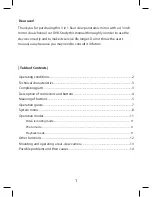
OPERATING AND USER MANUAL QUARTZ series CXP
44
The underlying principle of the multislope is in varying the pixel charge capacity of the sensor in steps.
This can be done up to 3 times within a single exposure time to achieve a maximum of the 3 exposure
slopes. This is illustrated in the figure 6.8.
The multi slope principle.
Figure 6.9:
The multi slope levels Vhigh and Vlow1 in figure 6.9, correspond to pixel reset and normal ‘single
slope’ sensor charge capacity respectively. The levels Vlow2 and Vlow3 are added in multi slope. The
red and blue curves illustrate the effect of the additional steps.
The red curve represents a pixel that receives a bright illumination. The blue curve represents a
pixel which is illuminated lower. As shown in the figure, the brightly lit pixel is affected twice by the
intermediate voltage steps that effectively temporarily limit the pixel capacity. Eventually after the total
exposure time this prevents the pixel from saturating.
The darker pixel is not influenced by this multiple slope and will have a normal response. The pixel
under bright illumination in figure 6.9 shows parts (horizontal lines) where the charge is constant.
Basically, this is intermediate pixel saturation. The saturation comes with additional fixed pattern for
which is not corrected for in the present camera.
The levels and exposure times are programmable via a command set as described below. This feature
results in the multi slope (piece wise linear) response curve as in figure 6.7. The placement of the knee
points depends on the specific Voltage and Timing programming.
The multi slope can currently only be used in Timed mode and in TimedTriggerControl mode.
Multi Slope Level node 1
Multi Slope Level node 2
Pixel reset
Pixel sample
Vhigh
Exposure kneepoint 2
Exposure kneepoint 1
Total exposure time
Pixel with bright illumination
Pixel with low illumination


































